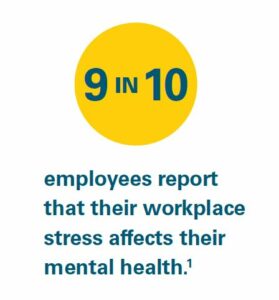Employee Burnout!
How workplace changes can impact behavioral health
The COVID-19 pandemic has redefined “workday” for millions of Americans. Many employers have switched to remote offices to protect their workforce’s physical health and have implemented new policies to safeguard those whose jobs cannot be performed remotely. Even before the pandemic, four in 10 employees stated that they struggled to navigate the demands that come with today’s more flexible, always-on work-life world.2 Now, it’s no surprise that the new normal is leading to increased behavioral health challenges for employees. Longer workdays, blurr ing of boundaries between work and personal life, greater caregiving responsibilities, fear of job loss and social isolation are contributing to a mental health crisis that was on the rise even before the pandemic. Add to that the stress over safety for those who are physically at work or transitioning back. All of this leads to the rise of one particularly worrisome mental health challenge — burnout.
ing of boundaries between work and personal life, greater caregiving responsibilities, fear of job loss and social isolation are contributing to a mental health crisis that was on the rise even before the pandemic. Add to that the stress over safety for those who are physically at work or transitioning back. All of this leads to the rise of one particularly worrisome mental health challenge — burnout.
However, there is good news. Although changes in the workplace during the pandemic have caused new challenges, they’ve also created opportunities. The door has been opened to more dialogue around behavioral health and highlighted the value — for employees and businesses — of a more flexible, supportive workplace. So, what can you do to best support the health of your employees? We’ll recommend actions you can take to build a new workplace culture of full health.
Big changes lead to bigger challenges — burnout
Burnout is defined as chronic workplace stress that has not been successfully managed.3 It’s no surprise that the workplace changes previously mentioned can lead to burnout. What may surprise you is how prevalent the problem has become. A full 75 percent of employees said they have experienced burnout at work, with 40 percent saying they’ve experienced burnout specifically during the pandemic.4
There are six main reasons burnout happens: unsustainable workload, perceived lack of control, insufficient rewards for effort, lack of a supportive community, lack of fairness, and mismatched values and skills.6 When it comes to your company, burnout can have a major impact on productivity if not managed successfully.

Think organizationally
While self-care is important, the real opportunity to address burnout is at the organization level, implementing changes to the way your organization works, rewards and interacts with one another to foster a true culture of health. And this goes beyond burnout. Addressing the various behavioral health challenges your workforce is facing requires fresh thinking and a top-down effort aimed at both long- and short-term strategies.
Reward hard work, not overwork
Now is the time to begin changing not just the workplace, but work culture as well. An 80-hour workweek isn’t a badge of honor, it’s a recipe for burnout — which will undoubtedly lower work quality. Making sure your employees have manageable workloads starts by clearly defining priorities.7 When employees better understand what’s expected of them, they’re better able to manage work-life integration. According to Dr. James Polo, executive medical director at Regence BlueCross BlueShield of Oregon, “Most companies have a mission. And, if our most valuable asset is our people, then taking care of our people allows them to take care of the mission.”
Train empathetic leaders
Improving workforce health may require employers to change how they manage people. Three in five employees are not receiving adequate support from supervisors to help manage stress.8 It’s essential that leaders and managers learn how to listen and respond effectively—and share their own behavioral health struggles so employees feel they’re not alone.
Educate your workforce
There are many things you can begin to shift right now. Don’t assume everyone understands burnout and its repercussions. Educate managers about how to spot and mitigate it. Drive employee awareness through educational campaigns, safe-space discussions and a mental health resource page. Unbundle your Employee Assistance Program (EAP) resources to help make them easier to find.
Offer more flexibility and support
Start looking for immediate ways to help your workforce navigate workplace stress and to support their mental well-being. Consider increasing PTO, accommodating different remote-work arrangements, encouraging employees to take time off and implementing flexible schedules—even PTO days for mental health.9,10
Care for the caregivers
More than half of unpaid caregivers don’t self-identify, which prevents them from seeking support while amplifying stress and isolation.11 By talking about and celebrating caregivers, employers can help employees take the first step toward recognizing their status as unpaid caregivers. These actions can help normalize caregiving, and reduce the
stigma associated with it.
Stay tuned
We’re all learning how important it is to focus on whole health and reduce the stigma of good behavioral health. Read more about building a workplace culture of health…during and beyond COVID-19 and supporting your employees’ full health.
References:
1, 5, 8 Taylor Adams, Madeline Reinert, Danielle Fritze, and Theresa Nguyen, Mind the Workplace 2021, Mental Health America, 2021.
2 MetLife, Navigating Together: Supporting Employee Well-Being in Uncertain Times, MetLife’s 18th Annual US Employee Benefit Trends Study 2020.
3 World Health Organization, “Burn-out an ‘Occupational Phenomenon’: International Classification of Diseases,” May 28, 2019.
4, 10 Brie Weiler Reynolds, “FlexJobs, Mental Health America Survey: Mental Health in the Workplace,” FlexJobs Blog, Aug. 21, 2020.
6, 7, 9 Jennifer Moss, “Beyond Burned Out,” Harvard Business Review, Feb. 10, 2021.
11 ARCHANGELS Caregiver Intensity Index Research 2019.